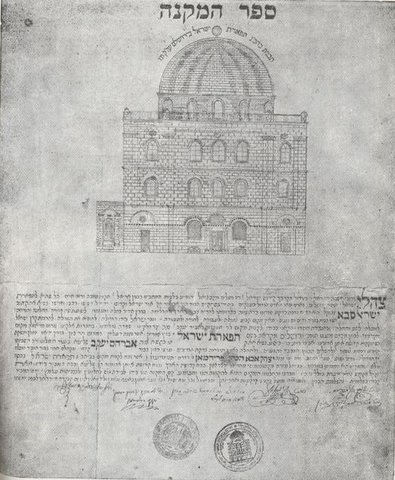|
Tiferes Yisrael Synagogue
Tiferet Yisrael Synagogue ( he, בית הכנסת תפארת ישראל; Ashkenazi Hebrew: Tiferes Yisroel), most often spelled Tiferet Israel, also known as the Nisan Bak Shul ( yi, ניסן ב"ק שול), after its co-founder, Nisan Bak was a prominent synagogue between 1872 and 1948 in the Jewish Quarter of the Old City of Jerusalem. The synagogue was inaugurated in 1872 by the Ruzhin Hasidim among the members of the Old Yishuv and was destroyed by the Jordanian Arab Legion on 21 May 1948 during the Battle for Jerusalem of the 1948 Arab–Israeli War. The synagogue was left as ruins after the recapture of the Old City in the Six-Day War. In November 2012 the Jerusalem municipality announced its approval for plans to rebuild the synagogue. The cornerstone was laid on May 27, 2014. Origins and name The synagogue was built in the 1860s by the followers of Rabbi Yisrael Friedman of Ruzhin and his son Rabbi Avrohom Yaakov of Sadigura, and was named "Tiferet Yisrael" aft ... [...More Info...] [...Related Items...] OR: [Wikipedia] [Google] [Baidu] |
Judaism
Judaism ( he, ''Yahăḏūṯ'') is an Abrahamic, monotheistic, and ethnic religion comprising the collective religious, cultural, and legal tradition and civilization of the Jewish people. It has its roots as an organized religion in the Middle East during the Bronze Age. Modern Judaism evolved from Yahwism, the religion of ancient Israel and Judah, by the late 6th century BCE, and is thus considered to be one of the oldest monotheistic religions. Judaism is considered by religious Jews to be the expression of the covenant that God established with the Israelites, their ancestors. It encompasses a wide body of texts, practices, theological positions, and forms of organization. The Torah, as it is commonly understood by Jews, is part of the larger text known as the ''Tanakh''. The ''Tanakh'' is also known to secular scholars of religion as the Hebrew Bible, and to Christians as the "Old Testament". The Torah's supplemental oral tradition is represented by later tex ... [...More Info...] [...Related Items...] OR: [Wikipedia] [Google] [Baidu] |

